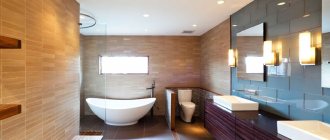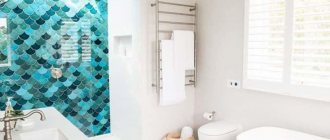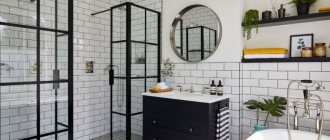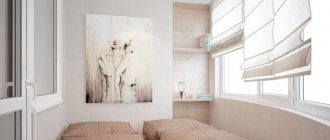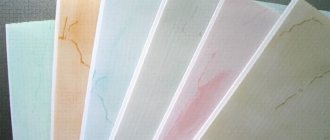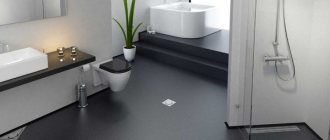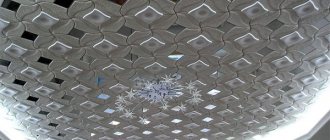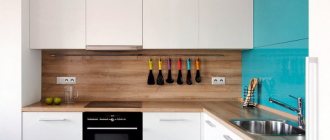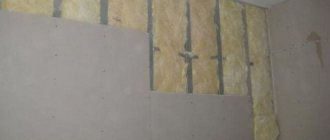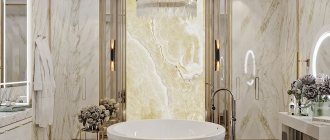Among the large selection of materials for wall cladding, PVC tiles stand out noticeably. This material is lightweight, environmentally friendly, and perfectly imitates a ceramic surface. Tiles or plastic panels can not only be glued directly to the surface of the prepared walls, but also installed on a frame made of metal profiles or on a wooden sheathing.
Types of Vinyl Wall Tiles
Rectangular and square type products are quite common on the market.
The tiles differ in the type of fastening:
- Self-adhesive.
- With lock fastening.
- No glue required.
Tiles are an excellent decorative element and have a rich, varied range of colors. PVC tiles can be patterned after wood, metal, pebbles, granite, etc.
Self-adhesive PVC tiles
Self-adhesive tiles are quite easy to install. This work can be performed by a person inexperienced in repair work. To install it, you just need to remove the top protective layer and attach the tile to the main working surface. The glue will set instantly, and the tile will hold tightly and reliably.
The most popular types of tiles are self-adhesive and without adhesive. These materials are appreciated by consumers and are actively used for finishing both residential and office premises.
Material characteristics
Plastic for the manufacture of wall panels and tiles is made from polyvinyl chloride, enriched during the production process with various modifiers and plasticizers.
The elements can be single-layer or consist of two thin layers of polymer, with longitudinal stiffeners located between them. Due to the presence of an air layer, tiling improves the heat and sound insulation of the room.
Decorative products can be produced by manufacturers in the following formats:
- tile-type panels - square, rectangular or other shapes measuring 300x300 mm or more, mosaics (individual tiles or modules);
- sheet – standard wall sheets with a width of 100 mm to 370 mm or plates up to 2 m wide;
- rack – strips up to 100 mm wide.
The tiles can be plain or decorated with various color patterns applied using thermal printing, and are additionally coated with a protective layer of special varnish.
The thickness of the decorative elements is 5-10 mm.
Plastic tiles can withstand temperature fluctuations from 30 ⁰С below zero to 80 ⁰С heat. The synthetic base of the components meets the requirements of hygienic standards; Even when exposed to ultraviolet radiation and heat, there is no release of toxic substances.
The total weight of the plastic cladding does not create a large load on the walls and ceilings, which makes it possible to use it in wooden houses.
PVC wall tiles in the bathroom
Polyvinyl chloride tiles are most often used in rooms with high humidity, such as a bathroom or toilet, as the tiles have some special characteristics:
- 1. Withstands temperature changes.
- 2. Waterproof.
- 3. Resistant to the formation of limescale.
- 4. Not prone to the formation of fungus and mold.
PVC tiles are an excellent solution for finishing damp rooms. It can truly replace expensive tiles.
Blue
The color of the sky will never go out of style. A blue bathroom is the dream of many romantic people, those who like to dream and fly in the clouds. Blue color relaxes, helps you forget about the bad and tune in to the positive. A blue bathroom will become a real relaxation room, which is so necessary after a hard day at work.
A variety of blue PVC panels are materials with white streaks randomly distributed across the canvas. The room will look very original and unusual.
Lilac
Lilac panels are considered a real trend this year. Lilac refreshes, uplifts and puts you in a positive mood. Surprisingly, the cladding of this shade exudes incredible light, and the panels themselves seem transparent.
Reds
Bright, bold shades are not for everyone. If you are a calm person and like to relax in a bubble bath, then it is better to choose a different color for the room. Red shades are invigorating, and to some extent incite aggression if the day was not very successful.
Kitchen wall tiles
PVC tiles are made of polymers and provide a durable and multi-layer coating due to the presence of quartz chips. Thanks to this, the material is rightfully considered durable, wear-resistant and ideal for finishing kitchen walls.
Preparation for installation
The result of the work depends on the correct preparation of the base. The coating must be smooth, dry and durable. Before choosing a primer and adhesive, it is important to determine the type of substrate for absorbency. Bases can be either water-absorbent or non-absorbent. Depending on this, the primer, glue and installation method are selected. More details in the video:
To avoid mistakes, you must take into account all the nuances specified in the instructions.
One day before the start of work, all building material is left in the room where installation will take place. This is necessary for proper acclimatization.
Instructions on how to glue PVC tiles
How to glue PVC tiles to the wall? The first thing to do is:
- Clean the work surface from cement, old tiles, paint, etc.
- Level the walls, removing possible waves and cracks.
- Apply antiseptic to the wooden work surface.
The most common types of installation: vertical or horizontal rows. This helps prevent moisture accumulation in the joints.
If horizontal laying is carried out, then it is better to start from the bottom rows. It is important to ensure the fit of the joints of the products. The closer they are to each other, the better the work will be.
Advantages and disadvantages
Like any other material, panels have strengths and weaknesses. The advantages of the products include the following product qualities:
- A good level of moisture resistance, thanks to which the panels are recommended for use in bathrooms.
- Fast and easy installation of products - anyone can cope with the task of installing MDF panels or plastic elements; it is enough to have minimal construction experience. To perform the work there is no need to purchase specialized tools; the products are lightweight.
- To install the panels, you do not need to provide a perfectly flat base, as required by the tiles.
- Thanks to the use of such products, the level of thermal insulation increases, since plastic and chip elements are warm raw materials.
- The level of sound insulation of the bathroom increases, which is important for residents of apartment buildings.
- The products have such qualities as strength and long service life, however, the correct installation of the products in this case plays an important role.
- The elements do not require special care; to keep the panels clean, it is enough to wipe the surface with a damp cloth and avoid prolonged exposure to water.
- Wear resistance and resistance to mechanical stress.
- An acceptable cost, which includes the absence of costs for the work of specialized hired personnel and the purchase of expensive consumables.
The disadvantages of moisture-resistant panels for the bathroom are:
- Unlike ordinary tiles, MDF finishing products swell when immersed in water. It follows from this that in situations where the bathroom is flooded from the top floor, the material will be irrevocably damaged.
- Low level of strength of panels upon impact.
- Some models lack grooves at the joints between products, due to which the gaps will need to be filled with sealant.
Vinyl tile adhesive
Regular vinyl tiles are installed using a special adhesive. Acrylic glue has proven itself well, as well as liquid nails.
Experienced craftsmen advise starting work on laying tiles from the center of the room, initially marking it as an intersection point using ropes stretched from opposite corners.
- After laying the fourth row, you can press it with a roller for a better fit.
- Exposed glue must be removed immediately with a stationery knife, as it hardens quickly.
- Rags cannot be used for this purpose; they will not remove it, but will only smear it over the surface.
This will negatively affect the appearance of the product. The work will turn out to be sloppy and of poor quality.
After finishing, you need to wait a day or two, then wash the tiles with soapy water.
Room design
Based on personal tastes and preferences, it is necessary to choose the material that would most successfully fit into the desired interior and realize the most daring decor ideas.
Today the market offers a huge selection of designs.
- For large rooms, it is more appropriate to use large samples with a three-dimensional pattern or original ornament. Also, juicy, dark, rich colors, for example, emerald, lemon, burgundy, etc., are perfect for rooms with a large area. Imitation of wood, marble, pebbles, and granite will look great.
- For a small kitchen or bathroom, light and white shades are preferable. They will help to visually enlarge the room, filling it with light. Ideal shades are: soft blue and pink, beige, cream, desaturated yellow and coral. If you wish, you can choose a small abstract ornament.
To create an original style with a touch of individuality, you can use products with patterns that imitate metal and wood. It is also worth considering brickwork as decoration. Today this is a fairly relevant and common finishing option.
Recommendations for choosing cladding
When choosing a facing material, be guided by the dimensions of the bathroom. To avoid waste of material, correlate the area of the cladding with the size of the products. But at the same time, you need to make a small supply of material, since the tiles will have to be cut to install them in the corners.
When choosing tiles, take into account the dimensions of the bathroom, following the rule that light shades add volume to a small room
Key points to consider when choosing high-quality polymer tiles:
- Material thickness. For wall cladding, you should choose dense panels with a thickness of 2.5-3.5 mm. If you plan to finish the ceiling, choose “lightweight” options with a thickness of 1-2 mm.
- Profiled substrate. The strength of the tile, combined with elasticity, largely depends on the thickness of the profiled substrate and the balance layer. After all, their main task is to distribute the load and prevent temperature deformation.
- Uniformity of coating color. When creating colored tiles, some manufacturers do not add coloring pigment to the polymer composition, but apply paint to the front side. This is fraught with the fact that the layer will fade faster during operation and be easily scratched.
When inspecting the product, pay attention to the thickness of the front surface. Ideally, the balance layer and the profiled substrate should not be visible through the outside.
To avoid discrepancies in color saturation and texture, it is necessary to select polymer slabs from the same batch
When purchasing tiles equipped with a tongue-and-groove system, it is advisable to try to connect the products together. The joint should be smooth, free of wrinkles and deformations.
How to care for PVC tiles
The material has good water resistance. Thanks to this, it is quite easy and simple to care for it. The surface is easy to clean with a regular soap solution.
PVC tiles are not prone to the formation of mold and fungi, this is a huge plus and makes them easier to care for.
- If persistent stains have nevertheless formed, you can use detergents for delicate cleaning against them.
- They do not contain abrasive substances, so they are not aggressive, but gentle, and will not deform the coating.
In this tile, you can easily drill holes for installing, for example, lamps, heated towel rails, hooks, etc.
Using high-quality materials and following the recommendations of experienced craftsmen, you can independently install high-quality PVC tiles, and by using your imagination and thinking through the design in advance, you can bring an original, modern, unique style to your home.
Tips for beginners
Beginning craftsmen should familiarize themselves with several points that may arise during the work process:
- Concrete bases are tested for their ability to release condensation (a piece of tape is left on the surface overnight).
- The styling pattern is selected in advance.
- The work is carried out quickly and accurately, defects are eliminated immediately.
- If the composition contains solvents, then attention should be paid to protecting the body and organs.
- The work begins with preparing the base.
- All contaminants formed during laying are removed immediately.

